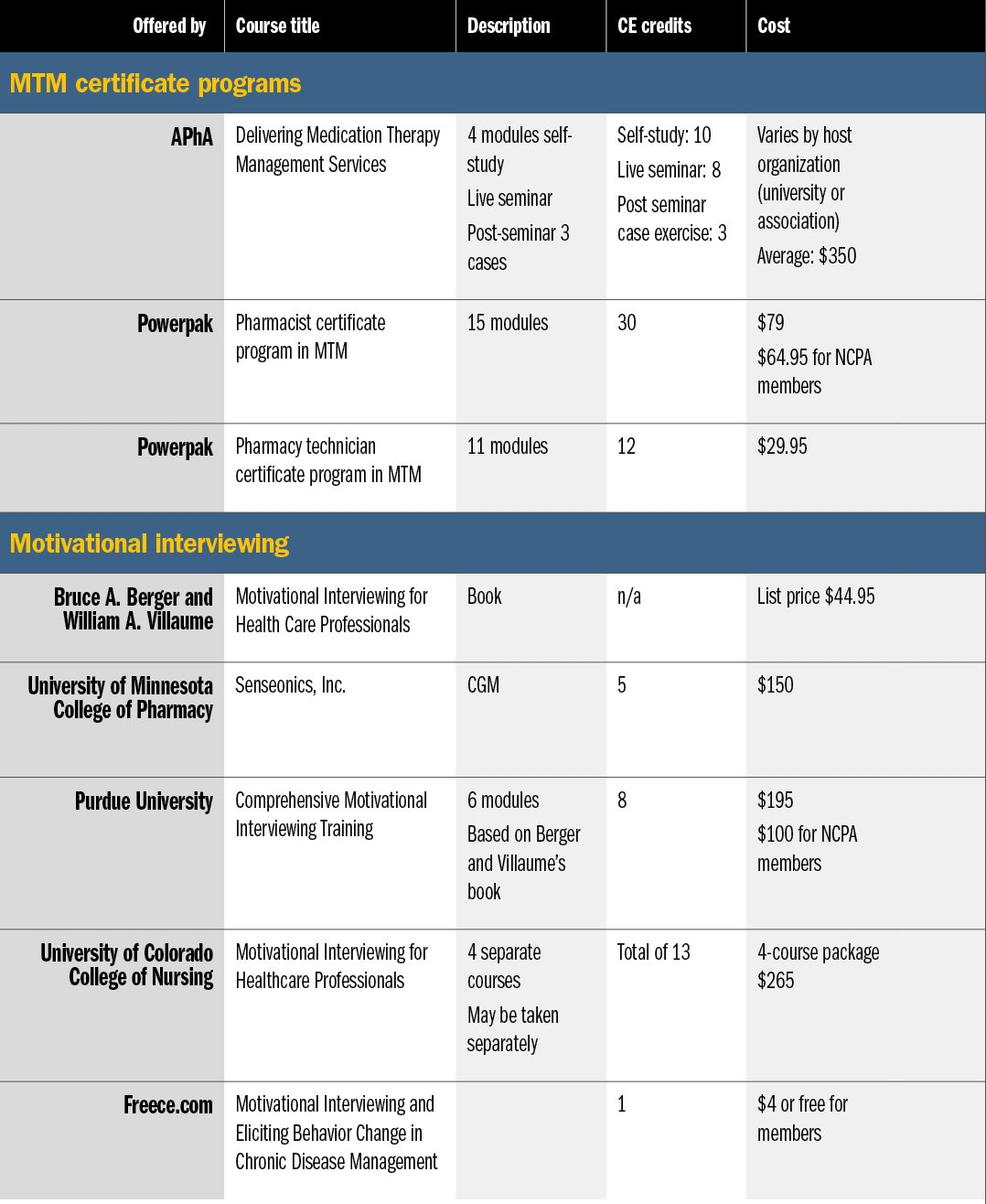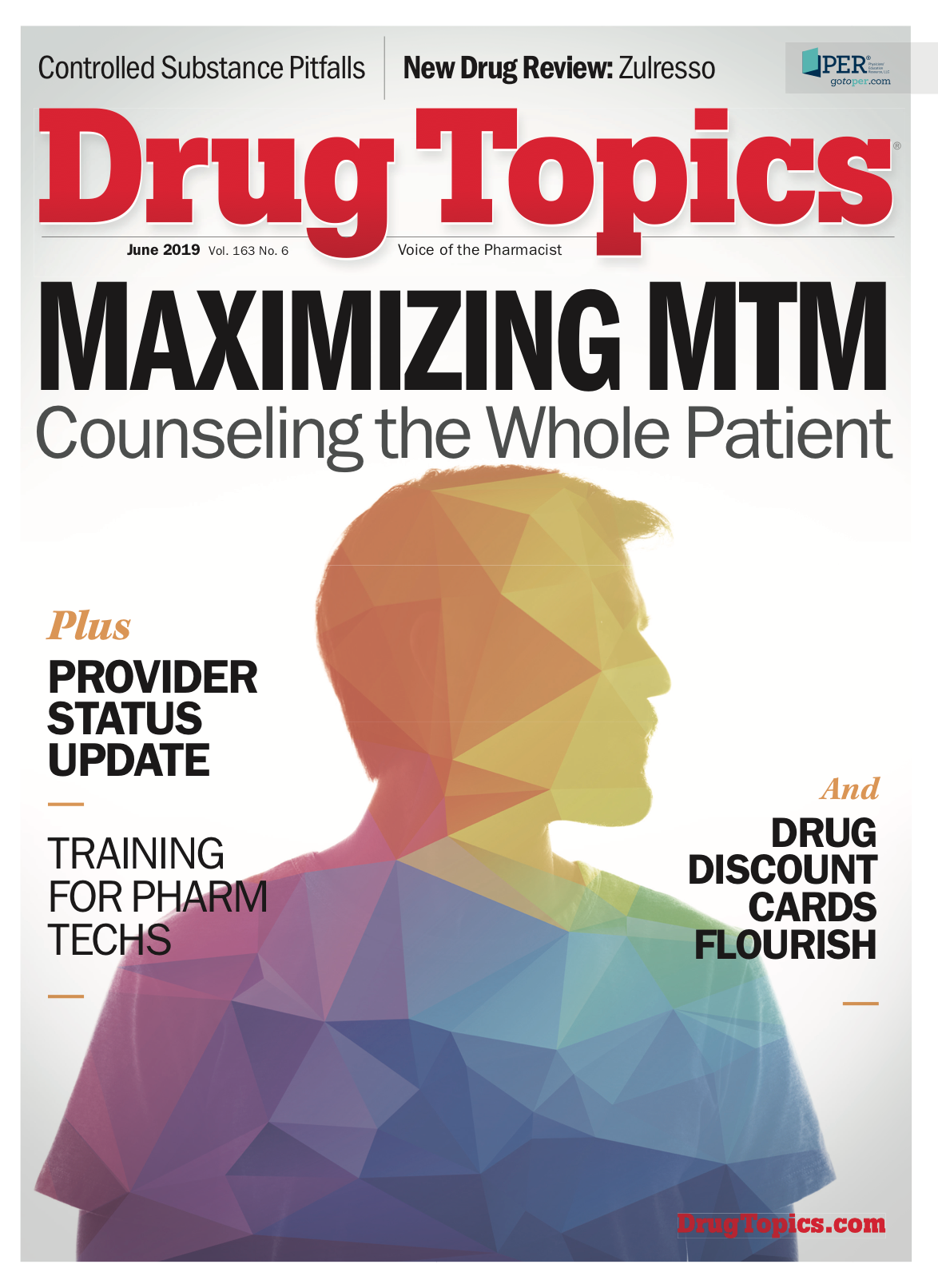Maximizing Medication Therapy Management Services
Improve your counseling skills to make the most of medication therapy management in your community pharmacy.

Educational Resources for MTM; Click to View

As product reimbursement falls and pharmacies must find other sources of income, medication therapy management (MTM) provides opportunities for pharmacists to increase revenue while using their clinical skills to make a difference in patient care.
“I think our value is no longer in the product-based world,” says Timothy W. Cutler, PharmD, BCGP, interim assistant chief, Department of Pharmacy at UC Davis Medical Center in Sacramento and clinical professor of pharmacy at the University of California, San Francisco. “We can’t get away totally from the product, but we have to be able to have the ability and the bandwidth to do the cognitive function that we were trained to do,” he says.
Monetizing Clinical Services
Income streams from MTM include not only direct reimbursement for comprehensive medication reviews (CMR) and targeted medication reviews (TMR), but also indirect reimbursement from decreased direct and indirect remuneration (DIR) fees based on improved quality ratings. According to Miriam Mason, PharmD, staff pharmacist at New Utrecht Pharmacy in Brooklyn, NY, the fee is about $60 for CMRs and $10 to $12 for TMRs.
“For a pharmacy with good volume, that can be a significant amount of revenue,” says Nikki J. Scott, PharmD, director of education at Harps Food Stores pharmacies in Springdale, AR.
What impact this will have on a pharmacy’s revenue stream depends on its contracts, Scott says. In pharmacies where DIR fees are assessed at the pharmacy level, effective provision of MTM can significantly impact pharmacy DIR fees in just three to six months, she says, adding up to tens of thousands of dollars quarterly. Pharmacies where DIR fees are assessed at the pharmacy services administration organization (PSAO) level can encourage improved quality of care across the PSAO, which in turn affects all the pharmacies’ DIR fees.
Trending: Proposed North Carolina Bill Could Increase Pharmacists' Immunizing Abilities
There are several resources that community pharmacists can use to increase and improve their MTM services. Rachel Stafford, PharmD, assistant professor of pharmacy practice at University of Arkansas for Medical Sciences (UAMS) College of Pharmacy says signing up with MirixaPro and OutcomesMTM is the bare minimum for community pharmacies. These programs allow a pharmacy to be assigned MTM cases from Medicare Part D plans. Pharmacy students on rotation are also a great resource, she says, and can probably accomplish MTM set up in a day. (Cardinal Health, owner of Outcomes, recently acquired Mirixa Corporation and plans on merging the two platforms.)
Stafford notes that when plans assess a pharmacy’s metrics, including adherence to different medication classes, they look at all the patients on the plan, not just those for whom MTM cases are being assigned. Pharmacy ratings also factor in a plan’s decisions whether to continue including a pharmacy in their network. Pharmacists can identify their nonadherent patients and work on improving metrics by using resources like the EquiPP platform and PrescribeWellness, she adds.
Continue reading on page 2...
Beyond MTM
Opportunities for reimbursement for comprehensive medication management (CMM) services outside the framework of Medicare Part D may not come easily, but they do exist. Since becoming an owner at Towncrest Pharmacy, with locations in Iowa City and Solon, IO, in 2006, Randy McDonough, PharmD, BCGP, BCPS has pursued multiple avenues to demonstrate the value of-and be reimbursed for-the continuous medication monitoring (CoMM) he provides. Towncrest stratifies each patient’s risk level based on medication regimen complexity and provides more intense clinical services for higher risk patients, making about 2000 clinical interventions monthly, he says.
In a 2013 pilot project with a major payer in Iowa, Towncrest was paid a professional fee to provide comprehensive case management for more than 600 high-risk patients, resulting in a cost reduction to the payer of approximately $300 per member per month. The payer subsequently developed a value-based pharmacy program through which 74 Iowa pharmacies are paid a performance incentive fee if they hit specified metrics, including total cost of care and clinical metrics.
Towncrest is part of an enhanced MTM model in selected regions of the country in which Medicare Part D reimburses for medication safety reviews. Other clinical services have included an expanded immunization program, employee health screenings paid for by local businesses, and case management services paid for by patients and organizations that care for physically and/or mentally disabled adults in group homes.
Stafford suggests that pharmacists interested in producing income streams for clinical services get to know the physicians in their area; find out about the physicians’ patient populations, their most common problems, and what they are being held accountable for. This information can open the door for collaborations where both pharmacists and physicians can benefit from incentive payments for improved quality metrics for their patients, she says.
Every state has a few value-based payment models, Stafford says. She encourages pharmacists to learn the new lingo of MACRA (Medicare Access and CHIP Reauthorization Act of 2015), MIPs (merit-based incentive payment systems), and APMs (alternative payment models) so they can understand how payment is flowing in the healthcare system and how pharmacists can get involved.
McDonough recommends that pharmacists who are looking to extend their clinical services join local community pharmacy enhanced services networks so that they can learn from colleagues and access other payment streams. Through his company, Thrive Pharmacy Transformations, he now offers a 30-week course called ‘Make Every Encounter Count,’ which guides pharmacists in transforming their practices.
Sharpening Clinical and Counseling Skills
Stafford says that the clinical skills needed to perform MTM are different from what retail pharmacists are used to. Instead of looking at individual drugs and assessing their interaction with other drugs the patient takes, she explains, pharmacists performing MTM must look at the total picture: the patient, his/her diseases, and how the various drugs in the regimen work together. They must ask, “Is that disease state controlled and, if not, why? Is it because the therapy needs to be optimized, because they’re not adhering to the medication, or both?” She believes that pharmacists, especially recent graduates with PharmD training, already have these skills, but need to practice using them.
Cutler notes that MTM is a more comprehensive approach that requires more follow-through with the prescriber and the patient. Learning to effectively communicate with physicians and phrase recommendations in a way that requires a yes or no answer is key in being able to make meaningful interventions, according to McDonough.
Since MTM requires pharmacists to become interventionists, McDonough says they must thoroughly understand therapeutics and current clinical guidelines. He endorses residency training and/or board certification in ambulatory care or geriatrics for pharmacists to improve clinical skills.
Read More: Scientists Are One Step Closer to Needleless Hepatitis B Vaccine
MTM certificate programs such as those offered by APhA and PowerPak “are really helpful for the didactic knowledge and its application in the individual patient,” says Cutler. He believes that pharmacists improve at these skills when they have more opportunities to practice them.
Fraidy N. Maltz, PharmD, BCACP, assistant professor of pharmacy practice at Arnold and Marie Schwartz College of Pharmacy and Health Sciences of Long Island University in Brooklyn, NY, says that the training provided by Mirixa and Outcomes is very helpful, and the online platforms include prompts that help pharmacists conduct and document MTMs.
Pharmacists must probe patients to find out important information, says Maltz. For example, if a patient discontinued a medication, is it because of side effects, cost issues, or because their lab values improved and they no longer need it? Patients’ concerns may be related to health or cultural beliefs or information they’ve heard, Cutler says. He emphasizes the need to work with the patient to dispel myths and reinforce facts, while recognizing that compromises sometimes must be made. For example, he says, “We may think that drug A is the cure and the best drug ever. But if the patient says I can’t afford that $50 copay, sometimes we have to modify to drug B, which is just about as good, but maybe not the perfect ideal drug, because it costs $10 and the patient’s going to take it.”
Pharmacists must recognize the importance of social determinants of health in adherence. The Pharmacy Quality Alliance has developed a framework describing structural, financial, and personal barriers that impact patient access to medications, including cost, transportation and insurance. McDonough says he is involved in discussions about how community pharmacists can work with local social services agencies to obtain help for patients with these barriers.
Mason, who provides MTM over the phone, finds that patients are sometimes resistant to accepting MTM services when they are offered. She feels it’s important to use sales techniques to enthusiastically convince patients to give their time to speak to the pharmacist. According to McDonough, CMM in the pharmacy results in a shift in patients’ perception as they move from a friendly relationship with their community pharmacist to a therapeutic relationship. He notes that patients’ recognition that the pharmacist is working to optimize their medication therapy has created tremendous patient loyalty.
Continue reading on page 3...
Fitting it in the Workflow
Assigned MTM cases that are not completed within a certain time frame disappear from the Mirixa and Outcomes queues and are assigned to a different pharmacy, Maltz says. So how can a pharmacy that fills hundreds of prescriptions daily find time for MTM?
As a pharmacy resident at the University of Arkansas for Medical Sciences and Harps Food Stores in 2015, Nikki Scott developed a workflow model that allows pharmacists to focus on the direct patient care aspect of MTM. The model trains pharmacy technicians to perform all nonclinical MTM tasks, including tracking and billing for patient cases, scheduling CMR appointments, preparing patient folders for the pharmacist, and performing follow-up prescriber communication. After the system was implemented in 35 Harps pharmacies, the pharmacies experienced statistically significant improvement in MTM completion rates, EQuiPP scores, and patient adherence to diabetes and hypercholesterolemia drugs, Scott says. Since this system does not require adding any staff hours, all the income generated from clinical services goes to the pharmacy’s bottom line. A training program for the model, called MTM The Future Today, is now offered throughout the country. More than 500 pharmacists and technicians have been trained, she reports.
Trending: Side Effects of the Shingles Vaccines
At Towncrest, pharmacists are available to perform clinical functions because the dispensing process is led by technicians, whom enter orders. They are aided by automated technology, including an automatic pill counter, a pouch packager, and a robot that fills and labels bottles. A new practice model in the state of Iowa permits technicians to check both other technicians and robots, so final prescription verification does not require pharmacists. The role of the pharmacist in the dispensing area is to perform CoMM to identify medication-related problems for each patient, a process that is streamlined because medication synchronization and compliance packaging has been achieved for one-third of their patients. Other pharmacists are available to follow through on time-consuming interventions so that work flow is not interrupted, McDonough says.
The Future of MTM
Cutler believes that, as pharmacy moves towards automation of the dispensing process, pharmacists will have more opportunity to be out in front, counseling and educating patients. Integrated systems that allow retail pharmacists to access patients’ medical records will improve pharmacists’ ability to make sound clinical decisions, he says.
As the healthcare system shifts towards a value-based approach, he predicts payers will soon start to invest in programs that demonstrate decreases in total patient care costs by managing high-risk patients with CMM. “The pharmacist’s role is just going to explode,” he says.
